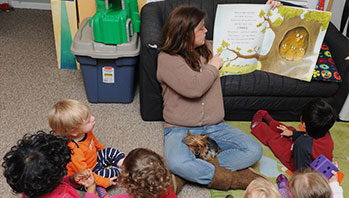- dance
- loud
- quiet
- scrape
- sound
- whisper
MA Standards:
Literature: RL.PK.MA.1 With prompting and support, ask and answer questions about a story or a poem read aloud.
Literature: RL.PK.MA.9 With prompting and support, make connections between a story or poem and one’s own experiences.
Literature: RL.PK.MA.3 With prompting and support, act out characters and events from a story or poem read aloud.
Language: L.PK.MA.4 Ask and answer questions about the meanings of new words and phrases introduced through books, activities, and play.
Head Start Outcomes:
Literacy Knowledge/Book Appreciation and Knowledge Asks and answers questions and makes comments about print materials.
PreK Learning Guidelines:
English Language Arts/Reading and Literature 6 Listen to a wide variety of age appropriate literature read aloud.
English Language Arts/Reading and Literature 10 Engage actively in read-aloud activities by asking questions, offering ideas, predicting or retelling important parts of a story or informational book.
Read Together: Kitchen Dance #1

© Commonwealth of Massachusetts, Department of Early Education and Care (Jennifer Waddell photographer). All rights reserved.
ELA Focus Skills: Concepts of Print, Listening and Speaking, Story Comprehension, Vocabulary
Before You Read
Tell children that you are going to read a book called Kitchen Dance by Maurice Manning. Hold up the book and point to the illustration on the cover. Ask children, What do you think the story is going to be about? Why do you think that? Say, I wonder what a kitchen dance is. Set a listening focus for children by having them listen to all the sounds that happen in the kitchen.
As You Read
Guide children to note the family’s movements as they dance in the kitchen. Pause to describe any sound vocabulary and also any unfamiliar vocabulary words.
- Model the movement words twist, tapping, glide, twirl, spin, sway, bend, sweep, bump and have the children act them out after you. Encourage children to twist and sway their own way as well. Say, What are some dance moves you know?
- Point to and read the sound words scrape, hmmm, clang, clunk. Ask, What kinds of sounds are these?
- Point to the word whispering. Ask, What is a whisper? Can you make a whisper sound with your voice? Do you think that the mother’s feet were loud or quiet?
After You Read
Review the book with children. Focus on the movements in the book. Ask questions such as,
- Now that we have read the story, what do you think a kitchen dance is?
- How were the mother and father moving in the book? Can you show me?
- Why do you think they were moving that way? How do you think they were feeling?
English Language Learners: Pull a few Spanish words from the text and ask children if they know what the words mean. Ask, Does anyone know what “Oye” means? If so, have them translate for the group. Then ask, When we come to another Spanish word, will you tell us what it means?
